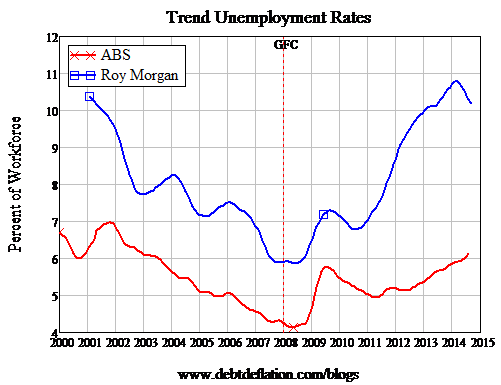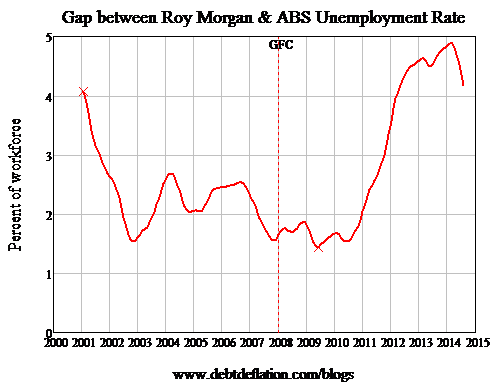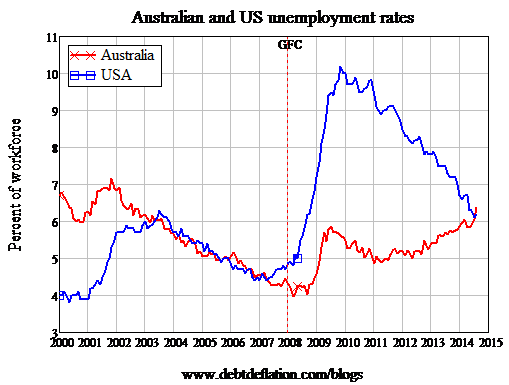The truth about Australia's unemployment rate 'shocker'
Hey, great news! Australia’s unemployment rate fell by 0.4 per cent last month! Did you hear?
You didn’t? That’s funny. I was sure Joe would tell you.
What do you mean, it rose by 0.4 per cent? Oh, you’re talking about the ABS figure! Yeah, that’s bad, but if you look at what happened to the Roy Morgan unemployment rate, the news is really good: it’s fallen from 10.6 per cent to 10.2 per cent! If this keeps up, pretty soon unemployment in Australia will be below 10 per cent!
Huh? You thought it was 6.4 per cent -- and that was bad? Actually, that would be really good if that were true.
Herein lies the problem with spin in economic data: sometimes the spin turns your way, sometimes it doesn’t. The ABS uses the internationally sanctioned definition of unemployment, which is similar to Tom Waits’ definition of being drunk: you have to be really, really out of it to qualify. Not only must you not be in employment, but you can’t have done even one hour of paid or unpaid in the four weeks prior to the survey. Nor can you be discouraged by the absence of available jobs either -- you must have applied for something in the previous four weeks -- and you must be available to start immediately.
Hands up all those who think they could survive on one hour’s paid work every four weeks? Thanks Eddie (and you too, Malcolm). And all those who wouldn’t be discouraged from applying for jobs you’re not really qualified for, after years of knockbacks? Thanks Tony (how is the new job going, by the way?). But apart from you three (OK Joe, you four), that excludes from the formal definition a lot of people who really are unemployed.
This so incensed the statistician and pollster Gary Morgan that since 2001 his company Roy Morgan Research has been running its own unemployment poll as part of its monthly consumer survey. It asks five straightforward questions, as detailed in a wonderful spray titled “Roy Morgan Measures Real Unemployment in Australia, not the ‘perception’ of Unemployment”:
The Roy Morgan Unemployment estimate is an accurate measure of the true state of the employment market in Australia based on what respondents tell us about their employment status. Those surveyed are asked “Are you now in paid employment” – If No: “Are you self-employed or a consultant” and if Yes: “Do you work full-time or part-time?” If still No: “Are you now looking for a paid job?” and “A full-time job for 35 hours a week (or more) – or a part-time job”. Those in part-time employment are also asked: “Are you now looking for a full-time job or additional hours?”
Gary Morgan and associates wrote that in response to a letter in The Australian by Australia’s then chief statistician Ian Ewing, in which he claimed that “the ABS labour force survey provides an objective measure of people's actual labour market activity, using endorsed international standards,” whereas “The Morgan survey measures people's perceptions of employment or unemployment status”.
Frankly, on this one I’m with Gary: the “endorsed international standards” are bunkum and have been ever since they were modified in the 1980s. By then it was obvious that the low unemployment years of the golden age of capitalism had come to an end, and there were two things that could be done about it: we could either have had a good hard look at why advanced market economies were leaving so many people without a job; or we could define the problem away.
I can’t prove that politicians were responsible for statisticians making the latter choice (though of course it’s provable that Joe and Eddie and Malcolm and Tony had nothing to do with it), but that’s what happened. Roy Morgan’s definition takes us back to the more honest measure that applied before the 1980s, and for that reason I follow it closely. As well as showing that unemployment is much worse than is officially recognized, it also highlights that the official measure understates unemployment more seriously during bad times than during good.
During the good times -- like from 2002-2008 in Australia -- the series follow each other closely, and the gap closes to about 2 per cent (see Figure 1).
Figure 1: The ABS and Roy Morgan unemployment rates

But when times turn bad, the gap expands because the ABS measure effectively ignores discouraged unemployed workers whereas Roy Morgan still counts them.
Prior to the July figures, the gap had reached the unprecedented level of almost five per cent (see Figure 2). I felt that the gap had to close at some point, with the ABS figure rising as the mining boom ended and our terms of trade declined.
Figure 2: The gap between the Roy Morgan and ABS figure grows as economic conditions deteriorate

So the 0.4 per cent jump in the ABS figures this week wasn’t such a shock to me. Combined with the 0.4 fall in Roy Morgan’s seasonally unadjusted number, it brought the gap back to within cooee of what it was during Australia’s mild economic slowdown back in 2001, though it is still twice the gap that applied in the good years from 2002 till 2010.
Roy Morgan’s rapidly deteriorating figures since 2011 also emphasise what even the ABS trend figures make obvious: the economy began to head south in late 2010 and it continues to do so now despite the housing boom.
Now that Australia’s official unemployment rate exceeds the USA’s (see Figure 3), it’s time to stop regarding the GFC as a joke that was played only on the northern hemisphere, or pretending that Australia’s exceptional policy response (including restarting a housing bubble) had nothing to do with keeping the pain of the GFC so low for so long.
Figure 3: Australia's unemployment rate now exceeds the USA's

The days of Australian exceptionalism are over, aren’t they, Joe?
















